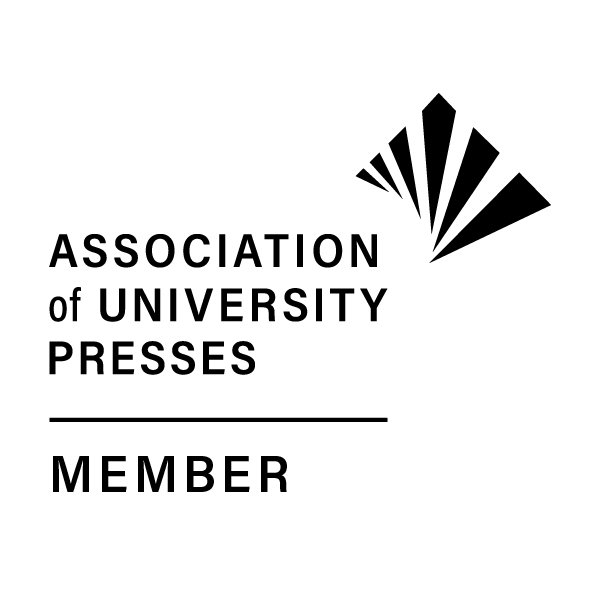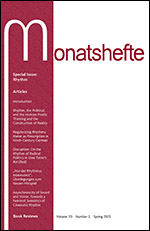|


|

Subscribe
Read the Journal Online
Submission Guidelines
Editorial Board
Receive Email Updates
Advertise in Monatshefte
Indexes/Abstracts
Current Issue TOC
Back Issues TOC
Monatshefte 2022 Subscription Rates
Institutions:
print & online $271
online only $233
Individuals:
print & online $103
online only $86
Non U.S. Postage (no postage charges for online-only subscriptions)
Airmail: add $40/yr.
Canadian Subscribers: add 5% GST. |
Monatshefte
Volume 95, Number 2, Summer 2003 Table of Contents
Special Issue: Johann Gottfried Herder 1744–1803
Articles
Hans Adler
Einführung. Denker der Mitte.
Johann Gottfried Herder, 1744 1803.
Abstract:
The introduction provides a brief overview of Herder’s achievements and his position within the context of the history of ideas. Recent research on Herder is presented as well as information on new editions, biographies, and translations of his works. A list of research desiderata and possible research topics concludes the introduction. (HA) (In German)
Daniel Weidner
‘Menschliche, heilige Sprache’: Das Hebräische bei Michaelis und Herder
Abstract:
The essay examines the role of Hebrew language in the writings of Johann David Michaelis and Johann Gottfried Herder. At the threshold of philologia sacra and the empiricist genetical understanding of language, Hebrew becomes an important model for general linguistics and poetics. Already for Michaelis, Hebrew is no longer conceived as perfect scripture but as a spoken language among others, moreover as a relatively primitive and—as opposed to the modern, ‘precise’ languages—therefore poetic one. For Herder, the new conception of Hebrew plays an important role from early on. In his thesis On the Origin of Language, Hebrew figures as the major example of an ‘original language.’ Paradoxically, the morphological structure of written Hebrew (priority of the verb, the ‘root’) becomes testimony of the oral origin of Hebrew and of language in general. In his biblical poetics however, the moment of writing reappears when Herder imagines the origin of poetry as a kind of material inscription. (DW) (In German)
Stefan Greif
“...wie ein Engel in Licht gekleidet”—Herders Bild- und Beschreibungsästhetik im Kontext des späten 18. Jahrhunderts.
Abstract:
Herder’s aesthetics is usually understood to be primarily an aesthetics of tactility. However, his ideas about the magic of colors (“Zauberey der Farben”) show that he is also keenly aware of the importance of color. This provides the aesthetic framework for a theory of ekphrasis. By way of comparison with Denis Diderot und Christian Ludwig Hagedorn, Herder’s role in the eighteenth-century discourse on visual aesthetics will be discussed. (SG) ( In German)
Jörg Esleben
“Indisch lesen”: Conceptions of Intercultural Communication in Georg Forster’s and Johann Gottfried Herder’s Reception of Kālidāsa’s Śakuntalā
Abstract:
Georg Forster’s 1791 translation of the drama Śakuntalā; by the classical Indian poet Kālidāsa and Johann Gottfried Herder’s writings about this translation had a lasting impact on the German reception of Indian culture. This study compares Forster’s and Herder’s conceptualizations of the translation and its reception as acts of intercultural communication. Both do important groundwork for such communication, which they see as crucial to the well-rounded Bildung of Europeans, and which both use to criticize their own culture. However, while Forster’s reflections tend towards a hierarchical model of communication characterized by a paternalistic attitude towards Indian culture, Herder takes the challenges posed by the intercultural encounter more seriously. The analysis of these correspondences and differences in conceptualizing intercultural aesthetic communication contributes to understanding the degree of variation that existed even among the more tolerant European attitudes towards non-European cultures at the turn of the eighteenth to the nineteenth century. (JE)
Ansgar M. Cordie
Hätte Herder Pagano gelesen... Ein diskurshistorisches Szenario
Abstract:
Johann Gottfried Herder owned a copy of Versuche über den bürgerlichen Lauf der Nationen (Essays on the Civil History of the Nations) by the Neapolitan advocat and revolutionary Francesco Mario Pagano. Pagano transforms the evolutionary model of history of Giambattista Vico into a series of natural and historical desasters that eventually lead to radically new cultures and a primitive egalitarian society. Pagano’s new myth of a primitive egalitarian society processes both the traumatic experience of desaster and epistemic ruptures. At the same time, that myth ignores the longue durée of mentalities, resulting in a dialectic of enlightenment. Had Herder taken notice of Pagano’s Essays he could have confronted Pagano’s systematic approach with an historical geography of European societies, starting from the “model of Renaissance Italy.” While Pagano does not figure in Herder’s writings, this article stages a fictitious discursive encounter that highlights the extent to which both authors’ concerns and approaches could have provided a productive supplement and counter-perspective to Herder’s philosophy of history. (AC) (In German)
Jochen Johannsen
Der Erfahrungswandel der Moderne und die Ästhetisierung der Geschichte: Aspekte der historischen Erfahrung bei J. G. Herder
Abstract:
After some initial remarks on the ongoing historiographic debates regarding experience as an analytical category, the article first tries to show, through a concise survey of J. G. Herder’s essays on Ossian and Shakespeare, that Herder cannot be claimed as a source for the notion of historical experience in the sense of an immediate access to the past, as the theorist of history F. R. Ankersmit has stated. Instead, the paper argues, experience can be understood as one of the key terms of Herder’s historical view of modernity, whose development he describes as involving a paradigmatic change in the character of human experience itself. For Herder, the shift from primary to secondary experience in the modern historical process results in the necessity of an aestheticization of historiography. In this respect, the article briefly concludes, Herder inspired 19th century historians such as G. G. Gervinus. (JJ) (In German)
Wulf Koepke
Klarheit und Wahrheit: Herders “Wende” nach 1787.
Abstract:
Against the widely held view in Herder scholarship that his seminal ideas are contained in his earlier writings, that his views did not change, and that his last period was one of regression and degradation—opinions already held by Goethe and Schiller—it is argued that Herder, at a time of close friendship with Goethe, began to take a new direction. This is indicated by four major texts published or written in 1787: Herder’s project for a “Patriotisches Institut” of the Germans; the third part of the Ideen, specifically book XV; the response to Spinoza’s pantheism in Gott; and the essay on “Bild, Dichtung, Fabel.” These texts contain the principles of Herder’s later philosophy, such as the unity of thought and image (or symbol); revival or reincarnation after death; the trinity of the true, the good, and the beautiful; and especially Nemesis, or Adrastea, i.e., balance, moderation, and retribution in history and human affairs. With the adoption of those principles, Herder adopted core positions of German Classicism. (WK) (In German)
Ulrich Gaier
The Problem of Core Cognition in Herder
Abstract:
In spite of his skepticism concerning the adequacy of knowledge in modern man, Herder dreamt the epistemological dream of knowing the essence of things—like Adam who named the animals according to God’s ideas. In his attempt to reconstruct the integral cognition of an integral human being as much as possible, Herder (like Oetinger) detects life that engenders life without mediation in the anthropos psychikos, and coherence as the formal principle that rules all systems from the organs of an animal body up to God whom he describes as “universal coherence”. In this systems approach, possibilities of core cognition are discussed in the senses (touch), in language (accent), in the working of imagination (mythology, fable), finally in the self-enhancement of the intellect (hieroglyph of creation). In all of these instances, a transcendental and a transcendent approach can be observed. (UG)
(Re)Readings—New Readings / Widergelesen—Neu Gelesen
Northrop Frye, Anatomy of Criticism. (1957)
Arnd Bohm, Northrop Frye: The Consolation of Criticism
Horst Lange, Northrop Frye, Anatomy of Criticism
Book Reviews
Berhorst, Ralf, Anamorphosen der Zeit. Jean Pauls Romanästhetik und Geschichtsphilosophie (Anette Horn)
Borchmeyer, Dieter, Richard Wagner. Ahasvers Wandlungen (Hans Rudolf Vaget)
Caemmerer, Christiane and Walter Delabar, Hrsg., “Ach, Neigung zur Fülle. . .” Zur Rezeption ‘barocker’ Literatur im Nachkriegsdeutschland (Thomas W. Kniesche)
Cook, Roger R., ed., A Companion to the Works of Heinrich Heine (Jeffrey L. Sammons)
Erspamer, Peter R., The Elusiveness of Tolerance: The “Jewish Question” from Lessing to the Napoleonic Wars (Irene Stocksieker Di Maio)
Espagne, Geneviève und Christian Helmreich, Hrsg., Schrift- und Schreibspiele. Jean Pauls Arbeit am Text (Anette Horn)
Gilmour, Simon Julian, daz sint noch ungelogeniu wort. A Literary and Linguistic Commentary on the Gurnemanz Episode in Book III of Wolfram’s Parzival (161, 9–179, 12) (Albrecht Classen)
Hallensleben, Markus, Else Lasker-Schüler. Avantgardismus und Kunstinszenierung (Bernhardt Blumenthal)
Hammer, Stephanie, Schiller’s Wound. The Theater of Trauma from Crisis to Commodity (Klaus L. Berghahn)
Hess, Jonathan, Reconstituting the Body Politic: Enlightenment, Public Culture and the Invention of Aesthetic Autonomy (Fritz Breithaupt)
Hurst, Matthias, Im Spannungsfeld der Aufklärung. Von Schillers Geisterseher zur TV-Serie The X-Files: Rationalismus und Irrationalismus in Literatur, Film und Fernsehen 1789–1999 (Peter Höyng)
Jones, Martin H. and Timothy McFarland, eds., Wolframs’s Willehalm. Fifteen Essays (Bernd Bastert)
König, Christoph, Hofmannsthal. Ein moderner Dichter unter den Philologen (Brigitte E. Jirku)
Koopmann, Helmut, Goethe und Frau von Stein. Geschichte einer Liebe (Cora Lee Kluge)
Lowry, Stephen und Helmut Korte, Der Filmstar: Brigitte Bardot, James Dean, Götz George, Heinz Rühmann, Romy Schneider, Hanna Schygulla und neuere Stars (Gerd Gemünden)
Maase, Kaspar und Wolfgang Kaschuba, Schund und Schönheit. Populäre Kultur um 1900 (Renate Werner)
Morris-Keitel, Peter und Michael Niedermeier, Hrsg., Ökologie und Literatur (Susan C. Anderson)
Murti, Kamakshi P., India. The Seductive and Seduced “Other” of German Orientalism (B. Venkat Mani)
Natter, Wolfgang C., Literature at War 1914–1940. Representing the “Time of Greatness” in Germany (Bernd Huppauf)
Neuhaus, Stefan, Rolf Selbmann und Thorsten Unger, Hrsg., Ernst Toller und die Weimarer Republik. Ein Autor im Spannungsfeld von Literatur und Politik (Helen L. Cafferty)
Pfeiffer, Joachim, Tod und Erzählen. Wege der literarischen Moderne um 1900 (Jürgen Pelzer)
Riethmüller, Albrecht, Brecht und seine Komponisten (Joachim Lucchesi)
Schutjer, Karin, Narrating Community After Kant: Schiller, Goethe, and Hölderlin (Astrida Orle Tantillo)
Wiesberg, Michael, Botho Strauß. Dichter der Gegen-Aufklärung (Jerker Spits)
Ziolkowski, Theodore, Berlin. Aufstieg einer Kulturmetropole um 1810 (Alexander Košenina)
Note
Books Received
Acknowledgment
|


